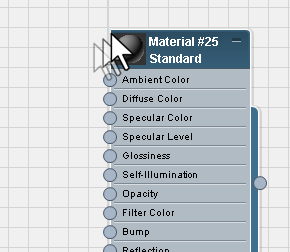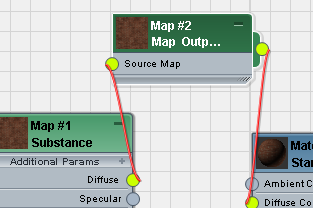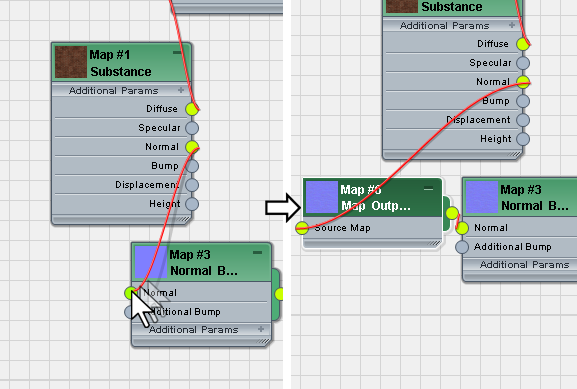Applies Substance parametric textures optimized for exporting to game engines.
A vast range of materials can be achieved using these dynamic, resolution-independent 2D textures with small memory and disk space footprints. Export via the Allegorithmic Substance Air middleware offering, with integration for Unreal ® Engine 3 game engine, Emergent's Gamebryo ® game engine, and Unity. Alternatively, you can use Render to Texture to bake textures to bitmaps for use with certain renderers.
Some examples of dynamically editable and animatable parameters are: brick distribution, surface aging, and mortar thickness in a brick wall; color variation, density, and leaf type in an autumn leaves texture; and the age and number of planks in a varnished wood texture. Also, every texture has a randomizing setting to lend natural variation to your scenes.
The remainder of this introductory topic includes procedures for using the Substance feature; the following topics provide sample renders of the textures and information about the software interface.
Procedures
Example: To use the Substance map in the Slate Material Editor:
- Open SME and, from the Materials list in the Material/Map Browser, drag a material into the active View. For this example, use the Standard material.

- From the Maps list in the Material/Map Browser, drag the Substance map to the Diffuse (or other) input socket on the Standard material.

- Double-click the Substance map node in the View.
Its parameters appear in the Parameter Editor on the right side of the Material Editor.

- On the first rollout, Package Browser, click the “Click to browse” button.
The Browse For Substances file dialog opens. By default it shows the two folders of included Substance files: Noises and Textures.
- For this example, open the Textures folder and then open the
BrickWall_02 Substance file.
Substance files have the file name extension .sbsar.
After you open the Substance file, 3ds Max automatically inserts a Map Output Selector map node between the Substance node and the material node. This node is necessary for most Substances, which produce several different output types (or channels) simultaneously. (Some Substances produce only one output type; these don’t need the Map Output Selector.) You can use the Map Output Selector to change the type of output of the Substance map that is connected to the material input socket without having to rewire the two nodes.

Because the Substance map produces different types of output, you can apply the same map to different material inputs, as in the following example, which shows how to use the Substance’s Normal output as a bump map.
- From the Maps list in the Material/Map Browser, drag the Normal Bump map to the Bump input socket on the material.

- Drag between the Normal input socket on the Normal Bump map node and the Normal output socket on the Substance map.
Again, after performing the wiring, 3ds Max automatically inserts a Map Output Selector node between the two nodes.

If you double-click each Map Output Selector node in turn, you can see that the first is set to the Diffuse channel while the second is set to the Normal channel.
- Apply the material to an object and render the scene. Adjust the Parameters and other settings and re-render to see how the changes affect the map output.
It is recommended that you use Substance in the Slate Material Editor (SME) rather than in the Compact Material Editor. If you would like to use Substance in the Compact Material Editor, however, a procedure for doing so follows this one.
Example: To use the Substance map in the Compact Material Editor:
- Choose a sample slot and change the material, if necessary.
- Click a map button for one of the material’s parameters, such as Diffuse, and assign the Map Output Selector map.
- On the Map Output Selector map’s Parameters rollout, click the Source Map button and assign the Substance map.
- On the first rollout, Package Browser, click the “Click to browse” button.
The Browse For Substances file dialog opens. By default it shows the two folders of included Substance files: Noises and Textures.
- Open a Substance file and set parameters as necessary.
- Click
 (Go To Parent) to return to the Parent Map Output Selector map and set Channel Name to the appropriate output channel, such as Diffuse.
Note: Because most Substances do not have as many output channels as the number of available map inputs in most materials, in some cases you’ll need to make do with what’s available. For example, to assign a Substance as a Filter Color map, try using the Diffuse output from the Substance.
(Go To Parent) to return to the Parent Map Output Selector map and set Channel Name to the appropriate output channel, such as Diffuse.
Note: Because most Substances do not have as many output channels as the number of available map inputs in most materials, in some cases you’ll need to make do with what’s available. For example, to assign a Substance as a Filter Color map, try using the Diffuse output from the Substance. - Right-click the Source Map button and choose Copy.
- Return to the material level and assign new Map Output Selector maps to other maps in the material as necessary. For each one, choose an appropriate Channel Name setting, then right-click the Source Map button and choose Paste (Instance).
This ensures that changing a setting in any of the Substance maps changes all of them simultaneously.
For ease of use, it is recommended that you assign Substance maps in the Slate Material Editor (SME) rather than in the Compact Material Editor. If you prefer to use the Compact Material Editor, however, follow this procedure: